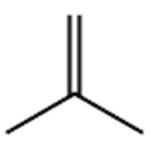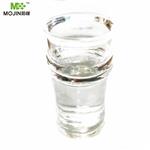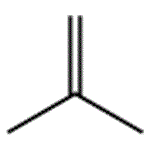Colorless gas with a coal gas-like odor. The odor threshold concentration is 10 ppmv Nagata and Takeuchi (1990). This gas can be liquefied under pressure. The substance has low solubility in water, soluble in organic solvent, easy to polymerize. It is nonexplosive; however, it forms explosive mixtures with air. Containers holding isobutylene under pressure may explode if heated. The boiling point and freezing point of isobutylene are -6.9°C (19.6°F) and -141°C (-221°F), respectively. Isobutylene is extremely flammable. It is stable under recommended storage conditions and no decomposition may occur if stored and applied as directed.
Isobutylene is used as a monomer for the production of various polymers such as butyl rubber, polybutene and polyisobutylene. The most important application of butyl rubber is the manufacture of tyres for cars and other vehicles. Other applications of butyl rubber, polybutene and poyisobutylene are lubricants (motor oils), adhesives, sealants and coatings. Another major use of isobutylene is the production of methyl-tert-butyl ether (MTBE) and ethy-tert-butyl ether (ETBE) which are gasoline blending components for cleaner burning fuels. Isobutylene is also used for the production of anti-oxidants, fragrances and gas odorization products.
Isobutylene is an easily liquefied gas that primarily used to produce diisobutylene, trimers, butyl rubber, and other polymers. It is also used to produce antioxidants for foods, packaging, food supplements, and for plastics: Hatch, Pet. Refin. 39, No. 6, 207 (1960).
Isobutylene is an important petrochemical raw material. In the pesticide industry, it is mainly used for the preparation of the organophosphorus insecticide terbufos, the pyrethroid insecticide permethrin and the acaricide pyridaben. Industrially, high-concentration isobutylene is mainly used for the production of polyisobutylene and copolymerization with isoprene to produce butyl rubber. The alkylation reaction of isobutene and isobutane can produce high-octane alkylated gasoline, and methyl tert-butyl ether obtained by reacting with methanol is an excellent gasoline additive.
ChEBI: isobutylene is an alkene that is prop-1-ene substituted by a methyl group at position 2. It is an alkene and a gas molecular entity.
Isobutene is produced in refinery streams by absorption on
65% H2SO4 at about 15�C, or by reacting with an aliphatic
primary alcohol and then hydrolyzing the resulting
ether.
Isobutylene is a colorless gas with a faint petroleum-like odor. For transportation it may be stenched. It is shipped as a liquefied gas under its own vapor pressure. Contact with the liquid can cause frostbite. It is easily ignited. Its vapors are heavier than air and a flame can flash back to the source of leak very easily. The leak can either be a liquid or vapor leak. It can asphyxiate by the displacement of air. Under prolonged exposure to fire or heat the containers may rupture violently and rocket. It is used in the production of isooctane, a high octane aviation gasoline.
ISOBUTYLENE is incompatible with oxidizers. ISOBUTYLENE polymerizes easily. ISOBUTYLENE reacts easily with numerous materials, such as alkyl halides, halogens, concentrated sulfuric acid, hypochlorous acid, aluminum chloride, carbon monoxide and hydrogen with a cobalt catalyst. Polymerization is catalyzed by aluminum chloride and boron trifluoride.
Highly flammable, dangerous fire and
explosion risk, explosive limits in air 1.8–8.8%.
Inhalation of moderate concentrations causes dizziness, drowsiness, and unconsciousness. Contact with eyes or skin may cause irritation; the liquid may cause frostbite.
Behavior in Fire: Containers may explode in fire. Vapor is heavier than air and may travel a long distance to a source of ignition and flash back.
Flammability and Explosibility
Extremely flammable
Groups of 50 male and 50
female F344/N rats were exposed to isobutene at concentrations
of 0, 500, 2000, or 8000 ppm6 h/day 5 days/week
for 105 weeks. Groups of 50 male and 50 female B6C3F1
mice were exposed to isobutene at concentrations of 0, 500,
2000, or 8000 ppm 6 h/day, 5 days/week for 105 weeks.
Under the conditions of these 2 year inhalation studies, there
was some evidence of the carcinogenic activity of isobutene
in male F344/N rats based on an increased incidence of
follicular cell carcinoma of the thyroid gland. There was no
evidence of the carcinogenic activity of isobutene in female
F344/N rats or male or female B6C3F1 mice exposed to 500,
2000, or 8000 ppm.
Schauer et al. (2001) measured organic compound emission rates for volatile organic
compounds, gas-phase semi-volatile organic compounds, and particle-phase organic compounds
from the residential (fireplace) combustion of pine, oak, and eucalyptus. The gas-phase emission
rate of 2-methylpropene was 40.1 mg/kg of pine burned. Emission rates of 2-methylbutene were
not measured during the combustion of oak and eucalyptus.
California Phase II reformulated gasoline contained 2-methylpropene at a concentration of 170
mg/kg. Gas-phase tailpipe emission rates from gasoline-powered automobiles with and without
catalytic converters were 15.6 and 427 mg/km, respectively (Schauer et al., 2002).
Photolytic. Products identified from the photoirradiation of 2-methylpropene with nitrogen
dioxide in air are 2-butanone, 2-methylpropanal, acetone, carbon monoxide, carbon dioxide,
methanol, methyl nitrate, and nitric acid (Takeuchi et al., 1983). Similarly, products identified
from the reaction of 2-methylpropene with ozone included acetone, formaldehyde, methanol,
carbon monoxide, carbon dioxide, and methane (Tuazon et al., 1997).
The following rate constants were reported for the reaction of 2-methylpropene and OH radicals
in the atmosphere: 3.0 x 10-13 cm3/molecule?sec at 300 K (Hendry and Kenley, 1979); 5.40 x 10-11
cm3/molecule?sec (Atkinson et al., 1979); 5.14 x 10-11 at 298 K (Atkinson, 1990). Reported
reaction rate constants for 2-methylpropene and ozone in the atmosphere include 2.3 x 10-19
cm3/molecule?sec (Bufalini and Altshuller, 1965); 1.17 x 10-19 cm3/molecule?sec at 300 K (Adeniji
et al., 1965); 1.21 x 10-17 cm3/molecule?sec at 298 K (Atkinson, 1990).
Chemical/Physical. Complete combustion in air yields carbon dioxide and water. Incomplete
combustion yields carbon monoxide.
(mole fraction):
In 1-butanol: 0.131, 0.0695, and 0.0458 at 25, 30, and 70 °C, respectively; chlorobenzene: 0.234,
0.132, and 0.0796 at 25, 30, and 70 °C, respectively; octane: 0.333, 0.184, and 0.119 at 25, 30, and
70 °C, respectively (Hayduk et al., 1988).
Dry isobutene by passage through anhydrous CaSO4 at 0o. Purify it further by freeze-pump-thaw cycles and trap-to-trap distillation. [Beilstein 1 IV 796.]



